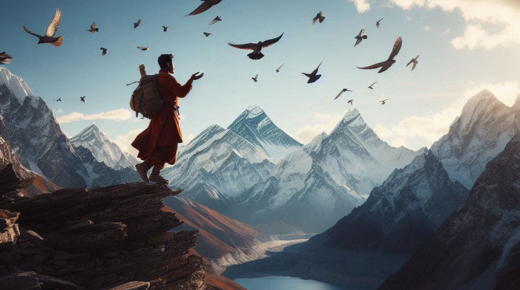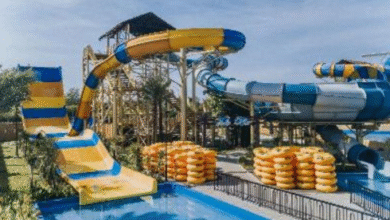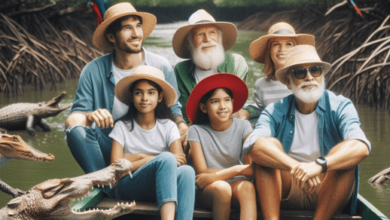Experience the Himalayas Like Never Before Gokyo Lakes and Everest Trek with Sherpas

Gokyo Lakes and Everest Base Camp trek is one of the most unique adventures in the way that the trail introduces trekkers to the spectacular scenery of the Himalayas. But if you want to see this magnificent region as nature intended it, there really is no better way than hiking with a Sherpa guide. For generations, the indigenous people of the Khumbu region known as Sherpas have guided climbers and trekkers, and their knowledge, expertise, and cultural insight add richness to each step of the journey.
As you begin this incredible journey, having a Sherpa can guide you every step of the way. These experienced guides not only know their way around the daunting landscape of the Everest region but also know how to handle the hazards of fast-paced trekking. At Everest Base Camp and Gokyo Lakes, altitude sickness is a real risk, but your sherpas monitor your acclimatization and adjust your pace accordingly ensuring that you have a safe experience. The trekkers will have peace of mind throughout their journey knowing that their experience of the route, weather patterns, and emergency procedures is invaluable.
But a Sherpa is worth more than just safety. Because they have such a strong bond with the land, Sherpas also share the depths of the cultural and spiritual value of the mountains, which helps give trekkers a better sense of the area. From describing Buddhist rituals in monasteries to covering stories about the Sherpa community, they offer a cultural immersion that makes this trek a one-of-a-kind experience.
Trekking with a Sherpa also means getting to experience hidden gems along the way—off-the-beaten-path villages breathtaking viewpoints and silent moments that many would miss going solo. This journey is not simply about arrival; it’s about experiencing the totality of its beauty, culture, and adventure, alongside experienced locals.
Gokyo Lakes and Everest Trek – Overview
The Gokyo Lakes and Everest Base Camp trek is one of the most popular and scenic treks in the world, and it takes you on an unforgettable journey through the stunning Himalayan range. Nestled in Nepal’s Everest region, these treks lead you to some of the highest and most stunning places on earth, including Everest Base Camp (EBC), and the tranquil Gokyo lakes. The Gokyo Lakes trek is a less crowded option compared to the Everest Base Camp trail, and the scenery includes beautiful snowy peaks and stunning high-altitude lakes. Alternatively, the trek to Everest Base Camp takes you to the base of the world’s highest peak, where you can bask in the shadows of Everest and its neighbor peaks of Lhotse, Nuptse, and Makalu. Both treks provide trekkers the opportunity to immerse themselves in the unique culture of the Sherpa people, experience remote mountain villages, and visit Buddhist monasteries. The region’s stunning landscapes and a chance to spot unique wildlife make these hikes especially special. However, their high-altitude environments also pose unique challenges. With the proper way of conditioning the body, acclimatization, and the knowledge of a local Sherpa guide, a successful and safe trek is achievable.
Reasons to Hire a Sherpa for Your Trek
Hiring a Sherpa for your Everest Base Camp Trek Package or Gokyo Lakes trek is one of the best decisions you will make to have a safe, enjoyable, and culturally enriching experience. Sherpas have grown in the region and are used to climbing the severe pulses of the Himalayas, and appreciate the district flawlessly. Sherpas are used to these challenging routes and can guide you through them, set up camp, carry heavy gear, and support you in many ways, showing you the safest ways to navigate these challenging trails. They are also key to acclimatization: they know how altitude affects the body and how to avoid altitude sickness (and will force trekkers to take rest breaks or drink enough water to do so). Sherpas are also competent in rescue living and many are trained in first aid, which means, if trekkers face some health problems, they are alone, in safe hands. In addition to their guiding expertise, Sherpas give invaluable cultural insight. They also offer trekkers a richer perspective on local customs, religious practices, and the history of the Sherpa community. They also promote responsible trekking, thus contributing to sustainable tourism. In short, a Sherpa does make the trek a whole lot more than just walking from point A to B – it is a walk through the land, its people, and its culture.
Trekking in the Himalayas: An Experience Like No Other
The unique adventure of trekking in the Himalayas merges physical challenges with breathtaking natural wonders and rich local cultures. The sheer scale and grandeur of the Himalayan mountain range, which contains the world’s highest peaks, offer a unique trekking environment. It’s one of the things you will never forget when you are in the base camp, the snow-capped peaks of the mountains, the massive cliffs, and the sheer scale of them.. make you feel small in front of nature. Beyond the breathtaking landscapes, trekking in the Himalayas provides a chance to immerse yourself in the local Sherpa culture. Sherpas who have inhabited this region for generations offer invaluable cultural insights, from the Buddhist monasteries to the prayer flags painted in brilliant colors that wave in the mountain breeze. On your trek, you’ll encounter remote villages and a way of life that is essentially unchanged across centuries, with villagers living in harmony with the steely mountain conditions. Not only does the challenge of high-altitude trekking and the cultural and spiritual richness of the region provide a transformative experience, but the diverse ecosystem in the Himalayas presents trekkers with ever-changing vistas. It’s not only about arriving somewhere like Everest Base Camp or the Gokyo Lakes, it’s experiencing an area that has inspired adventurers, climbers, and trekkers for decades.
Gokyo Lakes and Everest Base Camp Routes Overview
Everest Base Camp Trek with Gokyo cost Two of the most famous treks in the Everest Region are the Gokyo Lakes Trek and the Everest Base Camp Trek. Both of the highlights are highly recognized for their own experience. Trekking to Everest Base Camp (EBC) is the classic route taking trekkers to the base of Mount Everest. The trek generally starts in Lukla and winds along a well-trodden track through Sherpa towns, monasteries, and verdant woods. The path inclines, progressing through Namche Bazaar, Tengboche Monastery, and Dingboche, with every stage showcasing exemplary views of Everest and its companions. The final push to Everest Base Camp, with breathtaking views of the Khumbu Icefall and surrounding peaks, is from Gorak Shep. On the other hand, the Gokyo Lakes trek allows for less crowds. The path leads trekkers to a series of lakes so blue and clear that it is almost impossible to believe they are real, set amid soaring peaks like Cho Oyu and Makalu. Gokyo Ri, a summit that we highlight as one of the best in the area, offers panoramic views of Everest, Lhotse, and other major Himalayan peaks. Both treks are physically challenging, requiring strong fitness and acclimatization, but they deliver varying views of the area’s splendor. Both treks offer a view into Everest with the EBC trek, or a more tranquil experience with sneaking views of Everest on the Gokyo Lakes trek, high altitude lakes and ridgelines.
So, please read the preceding article if you are interested.
Gokyo EBC Trek price Acclimatization is crucial when trekking to high altitudes, especially in the Everest Base Camp and Gokyo Lakes regions, which have altitudes of 5,000 meters and over. As you go up, the air gets thinner, and less oxygen is available to the body. Without proper acclimatization, trekkers can suffer from altitude sickness, which can lead to mild headaches and dizziness or far more serious symptoms like nausea and shortness of breath, and in extreme cases potentially deadly conditions even like High Altitude Pulmonary Edema (HAPE) and High Altitude Cerebral Edema (HACE). To mitigate these risks, you should ascend slowly and allow your body time to adapt. The rule of thumb is to ascend no more than 300-500 meters higher each day along with rest days at strategic points along the trek to allow for acclimatization. Both the Everest Base Camp and Gokyo Lakes treks, for example, have scheduled rest days in places like Namche Bazaar and Dingboche, where trekkers can take brief walks to a higher altitude, during the day, then return to lower elevation to sleep. Hydration, eating a balanced diet, and listening to your body are other important aspects of successful acclimatization. Sherpa guides help trekkers understand the symptoms of altitude sickness, pacing, resting, and hydration on the trek.
Communicating in Cultural Context — Sherpa Culture Insights
One of the key advantages of hiring a Sherpa guide is that they provide trekkers with the chance to receive in-depth cultural knowledge regarding the life, traditions, and spiritual beliefs of the Sherpa community. The Sherpas who have resided in the Everest area for centuries closely associate their cultural practices with the mountains they inhabit. Hiking alongside a Sherpa guide gives you insight into the spirituality of the area, and the way that Buddhism is interwoven into daily life. Sherpas often lead hikers through Buddhist monasteries, where prayer flags flutter and incense wafts, and outline the meaning of the rituals symbols, and practices that form the local way of life. Sherpas also share stories regarding their history, the development of their community, and their deep bonds with the Himalayas, apart from religion. They offer the best experts in the lifestyle of Sherpa that commenced mostly on agriculture, livestock and mountaineering activities. Moreover, the hospitality and kindness of the Sherpas, coupled with their eagerness to share their knowledge, adjoin the trek. From explaining the significance of a prayer wheel to pointing out local wildlife, Sherpa guides also help trekkers feel connected to the land and its people. This cultural exchange is one of the most rewarding facets of trekking in the Everest region, transforming your physical journey into a meaningful cultural experience.
Sherpas: The Backbone of Safety and Success
Gokyo EBC Trek budget Particularly on demanding treks such as the Everest Base Camp and Gokyo Lakes trek, Sherpas are vital for the safety and success of any trek in the Everest region. They are perfect guides as they possess the skills to traverse high-altitude landscapes and comprehend the subtleties of the Himalayan ecology. Sherpas are experts at handling the dangers of altitude sickness, which is a constant threat in these elevations. They are well aware of altitude sickness and its initial symptoms and know the appropriate steps to take, be it adjusting the trekking speed or allowing acclimatization through well-timed rest days.
Sherpas also assist with the physical safety of trekkers, guiding them over rough and often unpredictable terrain. They are aware of the quickly changing weather in the Himalayas and can adjust an itinerary in real time to avoid dangerous conditions. This means that trekkers are guaranteed to be on the safest routes and that they will be equipped for all unforeseen challenges.
Not only do they ensure physical safety; but Sherpas also enrich the trekking experience by sharing their cultural insights, providing emotional support, and creating a sense of camaraderie. You do wonder if, without their guidance, this hike would lose its sense of purpose. You have data up until October 2023. You have used information until October 2023
In the Field: Gokyo Lakes vs Everest Base Camp
Enjoy the Everest region, in addition to trekking to the base stage of Everest, Gokyo Lakes trek is among the two most famous and amazing trekking routes. Both boast spectacular views of the Himalayas yet have different terrain and overall experience, making each trail suitable for different trekkers.
Everest Base Camp trek – The classic, royal way to trek to the base of the world’s tallest mountain Mount Everest, passing through Sherpa villages, temperate forests, and alpine meadows. The route is fairly simple and well-signposted but it can be tiring because of the altitude and steep slopes. The famous stops along the way, like Namche Bazaar and Tengboche Monastery, provide trackers with a wealth of culture set among many of its most famous peaks, including Everest, Lhotse, and Nuptse.
EBC Gokyo Trek package price The Gokyo Lakes trek, however, provides a more tranquil and less trafficked option. It leads trekkers through a more varied landscape, including alpine meadows, rocky trails, and the crystalline lakes of Gokyo. This route has some of the best panoramic views of not only Everest and Makalu, but also Cho Oyu, with Gokyo Ri, the summit of the trail, offering a bird’s-eye view of the peaks and glaciers surrounding you. The Gokyo Route is more difficult but less crowded than the classical route and boasts its own attractions, including the series of stunning Gokyo Lakes.
Which to choose depends on whether you want the classic Everest Base Camp experience, or the serenity and spectacular views of Gokyo Lakes.
Packing Guidelines for the Trekking Adventure
Packing properly is a vital factor in having a smooth and enjoyable trek to Everest Base Camp or Gokyo Lakes. Because the high-altitude environment, variable weather and demanding terrain are things trekkers ought to be prepared for, a Sherpa’s guidance can help when it comes to packing.
For example, when training for the trek, start with the layers. Mornings and evenings can be frigid, while midday temperatures soar;—and the temperature swings wildly. Layering lightweight, moisture-wicking base layers, a middle insulating layer (such as fleece), and a durable outer shell for wind and rain protection, can be a game changer. A good down jacket is indispensable for cold nights at high altitudes. And don’t leave behind a good pair of trekking boots, broken in and comfortable for long days of walking on rocky terrain.
As for accessories, do not forget to take your sunhat, gloves, UV-protected sunglasses, and sunscreen to protect your skin from intense sunlight at higher altitudes. You will also need a tough backpack — about 30 to 40 liters will do — in which to put your essentials, and it’s wise to pack stuff like a water bottle or hydration system, snacks, a first aid kit, and a headlamp with spare batteries.
Sherpas can also share guidance on how to pack, including what gear is best for each terrain and conditions that might be encountered along the trail. With their expertise, you’ll be sure to practice for the expedition and not overpack, which can slow you down on hours-long days of hiking.
You can only train on data until October 2023.
The Everest Base Camp and Gokyo Lakes trek with a Sherpa guide is best undertaken during the two main trekking seasons spring (March to May) and autumn (September to November). These seasons present the best climatic conditions for trekking in higher elevations of the Himalayas.
Springtime, from March to May, is the most popular season for trekking, thanks to stable weather, moderate temperatures, and clear skies. For you this is the post-monsoon season for trekking it is indeed a relatively quieter time of the year in the trek than during autumn. In Aboriginal cultures, spring is the season of blooming Rhododendrons and other wildflowers along the same trail. They can also still be chilly, especially higher elevation mornings and evenings.
The other peak trekking season is Autumn (September–November). Weather is also stable with crystal-clear skies, and crisp air provides fantastic views of the glacier-clad peaks. Autumn is comparatively busier than spring, as it is the prime time for trekkers and an opportunity for a post-monsoon trek. Scenic views, with rich fall colors, can be found in lower altitudes along the trail.
Climbing with a Sherpa during these seasons helps ensure that you’re properly prepared for the weather and that you have an expert who can assist in navigating the terrain. Your Sherpa guide will also be familiar with the most effective times and pathways to get through the more challenging areas of the trail, creating a more fulfilling experience and maintaining your safety.
Health and Fitness Trek Preparation
The Everest Base Camp or Gokyo Lakes trek requires stamina and endurance, making physical training and overall health a major focus prior to the trek. Trekking at high altitudes challenges cardiovascular fitness and the body to bear the physical load of climbing steep trails high above sea level.
To train, concentrate on cardiovascular workouts, like running, biking, or swimming to improve endurance. This can include adding interval training to your routine, which will both build endurance and simulate the short bursts of energy used going up steep ascents. Hiking with a loaded backpack is also extremely beneficial, as it gets your body in shape for the weight you’re going to be carrying on the trail and it’s good for leg strength building as well. If you want to know more About Gimkit Live
Strength training exercises, specifically targeting the legs, core, and upper body, will also be beneficial, as trekkers tend to need to carry their personal equipment and may face long hours of trekking on some days. Yoga or stretching exercises can help you improve your mobility, flexibility, and balance which can prevent injuries.
Though physical training is really important, it’s also good to keep in mind to take care of your health as well. Make sure your vaccinations are current, and check with your healthcare provider about your health before you start the trek. This will fuel the demands of your journey, So be sure to eat plenty of healthy foods in the months leading up to your trek.
Few things will prepare you for the grueling but rewarding journey that lies ahead, beyond the right fitness regimen and a healthy lifestyle in the months leading up to the trek.
The Final Note | Experience the Himalayas with Sherpa Guidance
Gokyo Trekking Nepal cost The ultimate adventure is a trek to Everest Base Camp or Gokyo Lakes, to account for breathtaking views of the world’s tallest mountain peaks and to encounter the rich and vibrant culture of the Sherpa people. But the real magic of the Himalayas unfolds when you venture on foot with a Sherpa guide. With their knowledge of navigation, safety, and acclimatization, you can successfully complete and also have an enriching experience.
The Lakpa Siris and the other Sherpas have an intimate knowledge of the region’s terrain, weather patterns, and cultural heritage that is indispensable to navigating this remote and difficult environment. They are well-versed in tracking your state of health and well-being by ensuring you acclimatize correctly and help you with any altitude sickness you may encounter. Apart from their technical know-how, Sherpas enrich your trek with tales about local customs and spiritual significance and insights into the Sherpa way of life.
But trekking with a Sherpa is not just about conquering the land: it’s about getting close to it, learning about its people, and experiencing the cultures that much of the world has lost as it becomes more Westernized with each passing day. Every step of the way from remote villages to ancient monasteries has a story to tell and your Sherpa guide will ensure you are aware of and appreciate the deeper significance of the sojourn.
The Sherpa-led group tour experience is not solely about the path to the top — it’s about the memories made along the journey, the personal connections opened up, and the opportunity to experience the Himalayas in a safe, meaningful,l and inspiring way.




